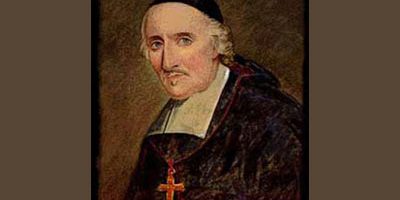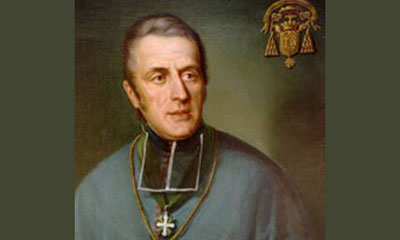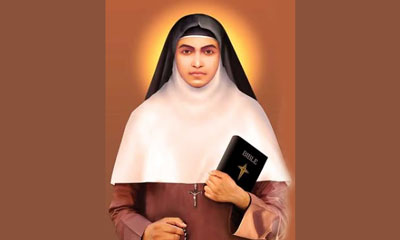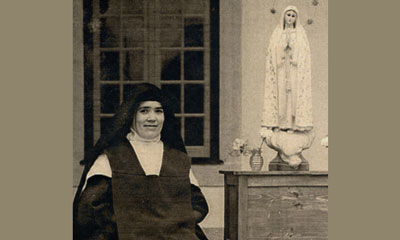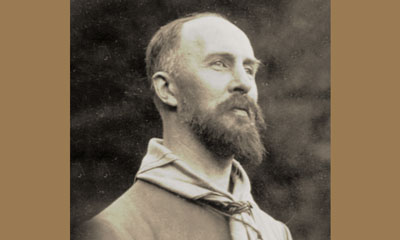December 13, 2017
Saint François de Montmorency-Laval
Dear Friends,
As a young bishop in New France (Canada), Bishop François de Laval was satisfied with poor and simply prepared food. Refusing any comfort in his accommodations, he slept on a hard surface and did not pay much attention to himself or his possessions, which he generously shared with the poor. He did not consider the humblest ministries beneath him, happy for example to administer Extreme Unction to the Indians. In 1659, when the Saint-André, a ship coming from France on which the plague raged docked in Quebec, he immediately went to the bedside of the survivors. The superior of the Ursulines of the city, Mother Marie of the Incarnation, commented, “We did what we could to prevent him for his own protection, but nothing could deter him from these acts of humility.”
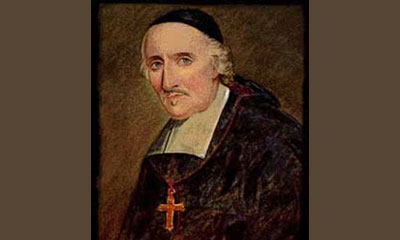 Although Hugues de Laval, Lord of Montigny-sur-Avre (diocese of Chartres, France) and his wife, Michelle de Péricard, came from high and ancient nobility, they were not rich. François, their third son, was born on April 30, 1623, and placed under the protection of Saint Francis Xavier, who had been canonized the previous year. They would have eight children, three of whom would be consecrated to the Lord. As was the custom in noble families of the time, the parents intended this third son for the ecclesiastic state. At the age of eight, François received the tonsure and put on the cassock. His education was entrusted to the Jesuits of the College of La Flèche, in Sarthe. When he was only thirteen years old his father died. His family then found itself in a precarious financial situation. Then the following year, 1637, his maternal uncle, François de Péricard, Bishop of Evreux, appointed his young nephew a canon in his cathedral, which provided him with a fixed income and, consequently, resources for his family. He was then able to pursue his studies. At La Flèche he joined the congregation of the Blessed Virgin, led by a professor, Father Bagot, who exercised a profound influence on the students. Within this fervent group, François’ priestly vocation was confirmed. At the age of eighteen, he left to study theology in Paris, at Clermont College, which was also run by the Jesuits.
Although Hugues de Laval, Lord of Montigny-sur-Avre (diocese of Chartres, France) and his wife, Michelle de Péricard, came from high and ancient nobility, they were not rich. François, their third son, was born on April 30, 1623, and placed under the protection of Saint Francis Xavier, who had been canonized the previous year. They would have eight children, three of whom would be consecrated to the Lord. As was the custom in noble families of the time, the parents intended this third son for the ecclesiastic state. At the age of eight, François received the tonsure and put on the cassock. His education was entrusted to the Jesuits of the College of La Flèche, in Sarthe. When he was only thirteen years old his father died. His family then found itself in a precarious financial situation. Then the following year, 1637, his maternal uncle, François de Péricard, Bishop of Evreux, appointed his young nephew a canon in his cathedral, which provided him with a fixed income and, consequently, resources for his family. He was then able to pursue his studies. At La Flèche he joined the congregation of the Blessed Virgin, led by a professor, Father Bagot, who exercised a profound influence on the students. Within this fervent group, François’ priestly vocation was confirmed. At the age of eighteen, he left to study theology in Paris, at Clermont College, which was also run by the Jesuits.
When her two eldest sons died in 1644 and 1645 in the army of Turenne and Condé, Madame de Laval called François back to Montigny and begged him to renounce his plans to become a priest, so that he could marry and take on the family estate, which was now rightfully his. Faithful to God’s call, François refused. Encouraged by his uncle the bishop, he put his family’s affairs in order and returned to Paris to complete his studies. He was ordained to the priesthood on May 1, 1647.
Missionary fervor
In the capital, he met up again with Father Bagot, who was continuing his work of spiritual formation among some former students of La Flèche, gathered together into a “Society of Good Friends.” All these young men were taken with the missionary fervor that, still in this first half of the seventeenth century, enflamed so many fervent Christians ever since the Pope established the Congregation for the Propagation of the Faith (De Propaganda Fide) in Rome in 1622, for the evangelization of distant lands. François dreamed of becoming a missionary himself, but he was waiting for God to give him a sign. After his ordination, he remained a year in Paris, teaching abandoned children and caring for the sick. In 1648, he resigned his honorary position as canon of Evreux, his uncle having appointed him the archdeacon for his diocese. For almost six years, the young priest solicitously fulfilled this duty, visiting parishes, reestablishing discipline, and providing for the relief of the poor.
He nevertheless continued in the “Society of Good Friends” in Paris. In 1653, the group received a visit from Father Alexandre de Rhodes, a Jesuit missionary in the Far East, who had come in search of volunteers to evangelize there. Twenty Jesuits had already agreed to join him, but Father de Rhodes also sought diocesan priests. François de Laval and several friends offered to join the Asian missions. He and Father Pallu were offered the posts of apostolic vicars of Cochinchina and Tonkin, Vietnam. However, this project was not realized because the Portuguese government claimed the sole right to operate Catholic missions in Asia, and firmly opposed the presence of French in the Far East.
Christianizing the social fabric
In 1654, François de Laval stepped down from his position as archdeacon of Evreux, and ceded his birthright to his younger brother, so he would be free to live his priesthood. He then placed himself under the direction of Jean de Bernières. Several years earlier, this layman had founded the Hermitage, a small community of priests and laymen devoted to prayer and works of mercy. He was also an active member of the Company of the Blessed Sacrament, founded and led by his friend Gaston de Renty. This society of laymen strove to Christianize the social fabric and further the reign of Christ at all times. Fifteen years earlier, de Bernières had been instrumental in the departure of the first Ursulines to Canada. This group included their superior, Mother Marie of the Incarnation, who would later be canonized.
The activity of these lay people, few in number but resolute in serving Christ, transformed the society of their time and bore fruit to the ends of the earth. “The changes in the order of the spirit and therefore of life are not linked to big numbers … It is not necessary to be in a large group to change our life: it suffices that the salt and leaven do not deteriorate. The great work to be performed is trying not to lose the ‘active ingredient’ which enlivens them: salt does not do its job by increasing in quantity—instead, too much salt makes the meal salty—but by saving its ‘spirit’, namely, its quality” (Pope Francis to the Focolare, February 4, 2017).
At the Hermitage, where he prayed, heard confessions, and cared for the sick, François very quickly became the close friend of his host, who strove to lead him on the path of spiritual poverty and renunciation that Christ Himself had taken. When he learned of François’ elevation to the episcopate, Jean de Bernières would exhort him to imitate the Apostles, who preached Jesus crucified to the point of sacrificing their own lives; to remain humble and content himself with little; and lastly, to beware of a worldliness too concerned with honors, which would keep him from being a perfect Christian.
Louis XIV wished to grant Canada a prelate. In 1658, Rome decided to erect an apostolic vicariate, and chose François de Laval to be its bishop, to the detriment of Monsieur de Queylus, the vicar general for the archbishop of Rouen, whose jurisdiction extended to New France. Displeased, the archbishop stirred up an outcry among the bishops of France, who challenged this appointment. Nevertheless, the nuncio proceeded with François de Laval’s episcopal consecration on December 8, 1658. The Parliaments of Paris and Rouen responded by prohibiting anyone from recognizing the new bishop as apostolic vicar, and ordering all the officers of the kingdom to prevent him from carrying out the least episcopal duty. In all this, François de Laval remained silent and abandoned himself into God’s hands. But the following year, 1659, the governor of New France was commanded in the name of the king to recognize the jurisdiction of the recently appointed apostolic vicar, and who was then able to embark on April 13. The evening of June 16, he arrived in Quebec, where he saw that his authority was not universally accepted. Queylus’ stubborn disobedience forced him to declare him “suspended from sacerdotal duties.” Shortly thereafter, the king summoned Queylus to return home. However, the apostolic vicar did not hold a personal grudge against Monsieur de Queylus for his intrigues, and later on succeeded in being reconciled with him, granting him permission to return to Montreal in 1668 and making him his vicar general.
“In the Gospel, Peter asks the Lord: If my brother sins against me, how often must I forgive him? As many as seven times? To which the Lord replies: Not seven times, I tell you, but seventy times seven (Mt. 18:21-22). These words,” comments Pope Francis, “go to the very heart of Jesus’ message of reconciliation and peace. In obedience to His command, we ask our heavenly Father daily to forgive us our sins, as we forgive those who sin against us … Jesus asks us to believe that forgiveness is the door which leads to reconciliation. In telling us to forgive our brothers unreservedly, He is asking us to do something utterly radical, but He also gives us the grace to do it. What appears, from a human perspective, to be impossible, impractical and even at times repugnant, He makes possible and fruitful through the infinite power of His cross. The cross of Christ reveals the power of God to bridge every division, to heal every wound, and to reestablish the original bonds of brotherly love” (Seoul, August 18, 2014).
Different points of view
Mother Marie of the Incarnation, the Superior of the Ursuline convent, found it difficult to accept the young bishop’s methods. Initially, their relationship was rather strained. However, the nun was profoundly knowledgeable in the matter of souls. She immediately admired François de Laval’s piety and virtue, and what is more, knew well who had trained him: “One must not be surprised if,” she wrote, “having been at this school (of Monsieur de Bernières), he has attained the sublime degree of mental prayer that we see in him.” However, she deplored his lack of diplomacy: “He is not one who will make himself friends in order to further himself and increase his revenue. He is dead to all that. Perhaps if he were not so, everything would go more smoothly, for one can do nothing here without temporal assistance.” The bishop’s plan to merge the two communities of nuns working in hospitals into a single community, and to unite the congregation of Our Lady with that of the Ursulines, was not to Mother’s liking. But the tension reached its peak in 1660, when after a canonical visit, he undertook to rewrite the Ursulines’ constitutions. Marie of the Incarnation was fiercely opposed to this, thinking the rules the prelate was attempting to impose were more suitable for Carmelites than for religious dedicated to education. “We will accept them,” she declared, “only if absolutely required by obedience.” Rather than persisting, the bishop chose to wait “so that more time might show us what we can do here for the glory of God and the greater good of your community.” Subsequently, he continually showed his goodwill towards the Ursulines, visiting Marie of the Incarnation several times when she was sick, placing the first stone of their chapel, and celebrating its dedication.
Detachment is essential
In 1660, François de Laval completed the first pastoral visit of his curacy. Founded in 1608 by Champlain, the French colonists in Canada numbered at that time scarcely more than 2,500—farmers but also merchants connected to the fur trade, grouped primarily around Quebec, Trois-Rivières, and Montreal. The natives, however, suffered a high mortality rate due to hunger, scurvy, and wars. In 1663, the prelate founded the seminary in Quebec, intended to train “young clerics to serve God by teaching them how to administer the sacraments well, to catechize and preach, to celebrate ceremonies, and Gregorian chant.” This center also became the home for the clergy, whose role was even more important in that for the time being it was necessary to forgo establishing parishes, because settlers were scattered across vast expanses, and funds were lacking, since many colonists were not yet able to help the Church financially. All the “parishes” were consequently linked to the seminary, which received income and provided for the priests’ support. In return, the priests pooled their resources. This renouncement was likewise valued from a spiritual perspective: “Detachment is essential,” the bishop explained; “in it is found the spirit of grace that sustains the seminary.” Supplies were provided to priests for however long their stay in a parish would be. When the priests returned to the seminary, exhausted by their ministry—which involved exhausting marches and difficult river trips—they received the care that their state of health demanded. After the curacy became the diocese of Quebec in 1674, Bishop de Laval would establish parishes with resident priests. When he stepped down in 1688, the bishop had established 35 parishes. But his greatest merit was the preservation of his young Church from the ills that, at the end of the seventeenth and during the eighteenth century, corrupted the Church in France: Gallicanism, Jansenism, quietism, the influence of “Enlightenment” philosophy… The faith inculcated by the pioneers of evangelization in faithfulness to the Church of Rome would be kept orthodox and pure.
A drink that kills
Soon, however, the prelate found himself in conflict with civil authorities. Indeed, Bishop Laval was trying to defend the poorest, and the Indians in particular, whereas Governor Davaugour was promoting trade in liquor. To obtain furs from the Indians at a cheap price, the traders offered them alcohol, which they had not known before the arrival of the colonists. The natives, wrote Marie of the Incarnation, “found it much to their liking. However, they needed try it but once to be rendered raving mad. This drink kills them.” The bishop did not hesitate to excommunicate those who indulged in “the trade in liquor.” Informed of the situation, the king called Davaugour back to France, and came to an agreement with the bishop on a new governor. A Sovereign Council of Canada was also instituted in which the prelate would take the second position. In November 1668, however, this Sovereign Council, while hypocritically prohibiting Indians from becoming intoxicated, once again authorized the “trade in liquor.” Courageously, the bishop took up the fight again. He was then accused of meddling in civil and commercial affairs. In the end, Louis XIV adopted a compromise—on May 24, 1679, he prohibited the trade of liquor outside of French settlements.
Today, Pope Francis also denounces certain economic attitudes, behind which are hidden a refusal of ethics and of God. “Ethics is regarded as counterproductive: as something too human, because it relativizes money and power; as a threat, because it rejects manipulation and subjection of people: because ethics leads to God, who is situated outside the categories of the market. God is thought to be unmanageable by these financiers, economists and politicians, God is unmanageable, even dangerous, because he calls man to his full realization and to independence from any kind of slavery.” (May 16, 2013) “The Catechism of the Catholic Church reminds us that, in reality (nos. 1718-1721), ‘God alone satisfies… God calls us to His own beatitude… what other end do we have, if not to reach the kingdom which has no end? God put us in this world to know, to love, and to serve Him, and so to come to paradise.’”
In 1681, Bishop de Laval had become very ill and offered the king his resignation. Louis XIV asked him to stay until his successor arrived. He would have to wait seven years—Bishop de Saint-Vallier would be ordained a bishop in January 1688. At that point François de Laval was given permission to live out his days in Canada, as long as it would cause no embarrassment to the new bishop. “His Excellency the Former Bishop,” as he was called from then on, settled in the seminary, and did not interfere in the least in the affairs of the diocese. Completely occupied with prayer and penance in solitude and poverty, he distributed to the poor all that he possessed, even giving them most of his meals. Nevertheless, he suffered under Bishop de Saint-Vallier’s administration. Under pressure from French political circles, the new bishop of Quebec rashly reworked the organization of parishes and sought to end the system of financing parishes through the seminary. He kept for himself the distribution of royal bonuses and refused certain priests the portion due them. In addition, he left to the seminary the responsibility of caring for and supporting exhausted and sick priests, without any compensation. The clergy were outraged.
A more powerful hand
In spite of the services rendered by the seminary to the city and the heroism of the elderly bishop during the attack by the English in 1690, Bishop de Saint-Vallier urged his predecessor to retire to his property, Saint Joachim, on Cape Torment. Bishop de Laval obeyed in silence, once again abandoning himself to the ways of Providence. His correspondence and even the packages his friends sent him arrived to him opened… The bishop of Quebec managed to obtain from the Court a ruling detaching all the parishes of New France from the seminary. The cross was bitter for the bishop emeritus. “But,” he wrote to one of his friends, “we must not be disheartened. If men have the power to destroy, the hand of Our Lord is infinitely more powerful to raise up. We have only to be faithful to Him and let Him act.” And he strove to console the priests, inviting them to obedience, preaching reconciliation and peace.
By the end of September 1694, Bishop de Saint-Vallier was at war with everyone, so His Excellency the Former Bishop felt it his duty to write him a long letter, in which he expressed in a straightforward manner everything a wounded father might say to a son who had crossed certain boundaries. Against all expectations, the bishop of Quebec turned completely around. Thanks to a stay in France, he perceived the wisdom of Bishop de Laval’s policy with regard to the self-serving financial ambitions of officers of the Court. In 1700, he left once again, and only returned thirteen years later, after a long captivity in England and exile in France. In his absence, his predecessor took his place in liturgical functions. His Excellency the Former Bishop undertook a pastoral visit, which he successfully completed in spite of great difficulties in traveling—maintaining a cramped position during long canoe trips caused him severe leg pain. He nevertheless continued his austere lifestyle—a bed, a table, a chair, a crucifix, an image of the Blessed Virgin and the Holy Family, were all the decoration in his room. His faith, his prayers, and his patience in trials made him the most sought-after spiritual advisor in the diocese—one left his presence consoled, enlightened, and comforted. In 1701 and 1705, he suffered the pain of seeing the seminary buildings, the cornerstone of his work, consumed by fires. But in spite of this, he never lost his peace, joy, or tranquility of soul, considering with Saint Paul that the sufferings of this present time are not worth comparing with the glory that is to be revealed to us (Rom. 8:18), for what no eye has seen, nor ear heard, nor the heart of man conceived, what God has prepared for those who love Him (I?Cor. 2:9).
In spite of the cold and his infirmities, he continued to attend all the offices of the cathedral, being carried there when necessary. But during Holy Week of 1708, he suffered a chilblain in his heel that became infected and eventually caused his death on May 6. He was 85 years old, and had lived in Canada for 49 years.
The life of Saint François de Laval bears witness to God’s faithfulness towards those who work to extend His kingdom. Let us welcome this witness with joy, as Pope Francis exhorted us to during the Mass of thanksgiving for the canonization of this saint and Saint Marie of the Incarnation, on October 12, 2014: “Honoring those who endured suffering to bring us the Gospel means being ready ourselves to fight the good fight of faith with humility, meekness, and mercy, in our daily lives. And this bears fruit.”


